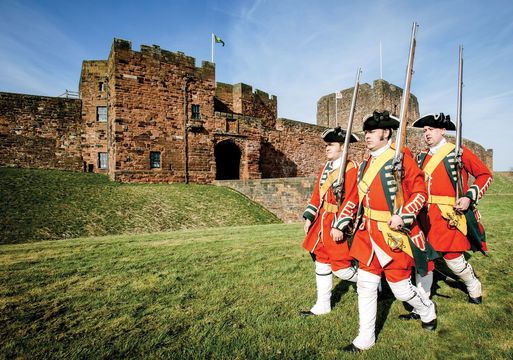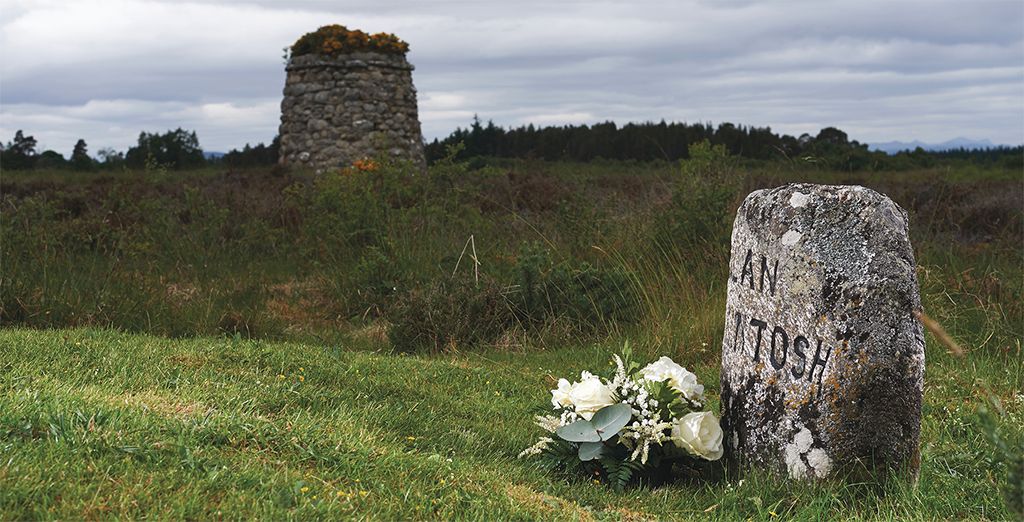
Carlisle CastleBHT
On a visit to Carlisle, the county town of Cumbria, Susie Kearley discovered a hive of history and heritage.
Carlisle is a major English city, on the border between Scotland and England. It’s jam-packed with heritage and has an impressive medieval castle, which has come under siege many times. Opposite the castle is Tullie House Museum and Art Gallery, where you can immerse yourself in artworks and see ancient artifacts, telling the story of Carlisle’s historic past.
Then there’s Carlisle Cathedral, a majestic masterpiece of medieval architecture. Stay for a service, or peruse the choir stalls, and admire the beautiful craftsmanship in this highly decorated church. It’s worth taking a look at The Old Courthouse too - they used to hang people from the gallows outside.
If you want to escape from the hustle and bustle of city life, visit Watchtree Nature Reserve, just outside the city. Here you can relax, walk through the grassy glades, and watch the wildlife pass you by.
Carlisle Castle
Carlisle Castle was the most frequently and ferociously attacked fortress in all the history of English vs Scottish conflict. It changed hands many times and was constantly under siege. It’s remarkable then, that so much of it still survives today. Inside the castle walls is the original castle keep dating to 1120. More recent buildings on the site, constructed in the 19th and 20th centuries, are still used by the Army Reserves.
There’s an exhibition showing the timeline for the Castle, starting in the days when a Roman fortress stood on the site in the year 78AD. The Castle was built to defend Carlisle against Scottish invaders in 1092 and you can read about the sieges and battles between the English and the Scots.
Step inside the castle keep and medieval-style decorations make you feel like you’ve stepped back in time. Some of the rooms have been recreated to reflect how they might have looked in the 12th century.
The Royal Chambers were created by King David I of Scotland. King David seized the castle following King Henry I’s death. He ordered the completion of the castle keep and lived in the Royal Chambers, which today, are decorated with wall hangings, as they might have been in the 12th century. Twenty-five men, including knights and crossbowmen, lived in the Castle, which at this time, was also a defensive fortress. King David died in the castle keep in 1153.
Read more
The Jacobite Rebellion
A series of spiral staircases lead to the third floor of the keep, where you get good views across the city. An exhibition about the Jacobite rebellion fills the upper rooms. On 21 September 1745, a Jacobite army of poorly-trained Highland clansmen charged the battlefield at Prestonpans near Edinburgh, against King George II’s army, to fight for Bonnie Prince Charlie’s claim to the throne.
Prince Charlie’s father, King James VII of Scotland (and King James II of England), fled to France in 1688 when William III of Orange, his son-in-law and nephew, invaded Britain with a Dutch army. The throne passed to King James’ protestant daughter, Queen Mary II, William of Orange’s wife. The following year the Bill of Rights was introduced, banning Catholics from taking the throne.
It was 56 years later, when King James’ grandson, Charles Edward Stuart, popularly known as ‘Bonnie Prince Charlie’, took action against the crown. He felt aggrieved that he was passed over as the natural successor to the throne because he was a Catholic. So he gathered an army and in 1745, his troops, barefooted, and in their tartan dress, fought passionately for their cause. Prince Charlie’s Jacobite army conquered Edinburgh, then marched south to Carlisle, where on the 10th November 1745, they issued an ultimatum to the people of the Carlisle: surrender or be ‘taken by assault’. The city had been preparing for this invasion and refused to surrender, firing at the approaching troops with muskets and grenades. However, on November 15th, 1745, Carlisle city and Castle surrendered. Two days later, Bonnie Prince Charlie rode victorious, through the center of Carlisle, accompanied by 100 pipers. His army continued south to Derby, but they were overcome by English soldiers and retreated north. Four-hundred Jacobite soldiers stopped at Carlisle to fend off English forces, resulting in another ten-day siege in Carlisle. It ended when the Jacobites surrendered and were imprisoned in Carlisle Cathedral.
The final battle took place at Culloden on April 16th, 1746, and ended in defeat for the Jacobites. Bonnie Prince Charlie, like his father, fled to exile in France. 382 Jacobite prisoners were sent to Carlisle Castle, to await trial. They were crammed into the dungeons, with little water or food, and no daylight. Two men died before receiving their sentence.
When sentencing had been passed, 20 of the prisoners were tied up and dragged through the streets of Carlisle to the English Gate, where the heads of their comrades were displayed. Then they were hung, drawn, and beheaded. The people of Carlisle were sickened and disgusted by the executions.
Walk along the ramparts and you’ll see canons between the battlements. Visit the remains of Queen Mary’s Tower - Mary, Queen of Scots, stayed at Carlisle Castle twice: once in residence and once as Queen Elizabeth I’s prisoner. Don’t miss the Border Regiment Museum, where you learn about the history of the local regiments and militia. You can also see the dungeons, where the defeated Jacobites awaited trial or execution.

Culloden
Tullie House Museum and Art Gallery
The first thing we learned when we visited Tullie House Museum and Art Gallery, was that we should have allowed more time! There’s lots to see, read, and explore. The exhibitions take you through different periods in history, with prehistoric rock art, stone circles, the Bronze Age, the Iron Age, the Roman Invasion, the Dark Ages, the Norman Invasion, the Middle Ages, the border reivers, and the Jacobite rebellion.
The Roman Frontier Gallery has original Roman statues, artifacts, and even the bones of a Roman murder victim - complete with a reconstruction of his face. There’s a Roman tent recreated in the center, with animal skin rugs on the floor and you can get inside and imagine what life was really like for people living in Roman Britain.
The Romans successfully conquered the southern half of Britain in 43AD. They valued the land for its abundant minerals, which included lead, used for water pipes, and pewter vessels. Britain was also an abundant source of silver.
Elsewhere in the museum, there are exhibitions about the construction of Hadrian’s Wall, Celtic gods and goddesses, Eastern religions, medieval crime and punishment, Carlisle under siege, and battles fought by the border reivers - the Scottish borders were disputed territory for centuries, and many of the people who lived there saw their lifestyles destroyed. They became thieves and bandits, as the only way to survive.
There’s also an exhibition about Victorian Britain, complete with 19th-century railway carriages, newsstands selling Victorian newspapers, and displays of Victorian clothes. At the back of the museum is Tullie House itself, with its magnificent staircase, impressive decor, and galleries of Pre-Raphaelite artwork and pottery. There’s another art gallery, changing exhibitions of modern artwork, a small shop, and a restaurant, so it's a good idea to allow plenty of time for your visit. We were rushed!
Carlisle Cathedral
Carlisle Cathedral was open for an hour after the closure of the museum, so we went to check it out and arrived just as Evensong was about to begin - it’s a half-hour service with a choir taking the lead, so we joined in and immersed ourselves in the whole experience.
As we sat on modern chairs, we gazed up at the ceiling, depicting golden stars painted against a deep blue sky. Along the walls are carved oak stalls, and the organ pipes are huge! The church interiors are fantastic and the choral music brings the whole experience to life.
The Cathedral was originally founded in 1122, as a priory for Augustinian Canons, who dedicated themselves to lives of holiness and poverty in the service of God. It was turned into a cathedral in 1133 and the prior, Athelwold, became the first Bishop of Carlisle.
The Augustinian Canons vacated the Cathedral in 1540 - no doubt encouraged by King Henry VIII. Then in 1650, much of it was demolished, leaving ruins around the main church building, which is still intact. The church that remains is one of the smallest cathedral churches in England.
Bitts Park
Bitts Park in Carlisle dates to 1894 when it was designed to help the people of Carlisle live fit and active lifestyles. Today the park is maintained for much the same purpose, with tennis courts, climbing equipment, and a skating rink, next to floral gardens and parkland.
There is a kiddies’ playground and at least four xylophone sculptures that visitors can play. A river runs through the park, so you can embark on a riverside stroll if you wish. There is ample room for ball games too, so it really is a place for everyone to enjoy. The floral gardens were named ‘Victoria Park’ in the late queen’s honor, when a statue of the Queen was erected a year after her death, in 1902.
Courthouse
If you walk through the town, you can see the old courthouse and gaol wall. They used to hang people from the gallows here - originally stringing them up just outside the gaol walls, but apparently the locals enjoyed it too much.
The authorities eventually decided that public hangings were too gruesome and tasteless - and that people were getting too much pleasure out of it! So they hung criminals inside the gaol walls instead. People gathered at the town gates to try and catch a glimpse of the executions, the last of which took place on March 15th, 1862.
There are some fantastic historic buildings in this part of the town, including a Victorian railway station and an old bank, now trading as a restaurant.
Watchtree Nature Reserve
Finally, we headed out of the city to see Watchtree Nature Reserve, which opened in 2002, following the devastating loss of livestock to foot and mouth disease; it devastated the farming industry in the UK at the time. The whole area, once an airfield, became a mass burial ground, and locals wanted to turn something so horrible, into something good, so they transformed the area into a nature reserve. Today it’s thriving.
The first thing we noticed was the wind turbines everywhere! They were there before the nature reserve, and don’t seem to bother the birds, so we were told. The wildlife has apparently become accustomed to them.
There are bird hides located all around and lots of small birds use the feeders. We sat quietly and watched as a hare appeared from the long grasses. The reserve is beautiful, and we spent a couple of hours walking around lakes, through woodland, and past boggy areas, watching out for wildlife on our way.
A Heritage City
Carlisle has a huge amount to offer visitors, with glorious historic buildings and plenty of heritage attractions. A short drive from the city is Hadrian’s Wall, a long Roman wall, built just under 2000 years ago, by the Roman Army who occupied England. The wall is 73 miles long and stretches the full length of northern Britain from sea to sea. Today, much of the wall is in ruin (parts are missing altogether), but parts of it are still remarkably intact. Hadrian’s Wall was designed to protect the Roman soldiers from the Scottish barbarians who would otherwise cross the border and kill them (some did). The wall also helped to protect the Roman’s position as a military power in England. Birdoswald Roman Fort, alongside Hadrian’s Wall, tells you more about life in Roman Britain.
Carlisle is the perfect place to unwind and explore while soaking up the culture, artwork, beautiful buildings, and dramatic history.
*Originally published in 2020.





Comments